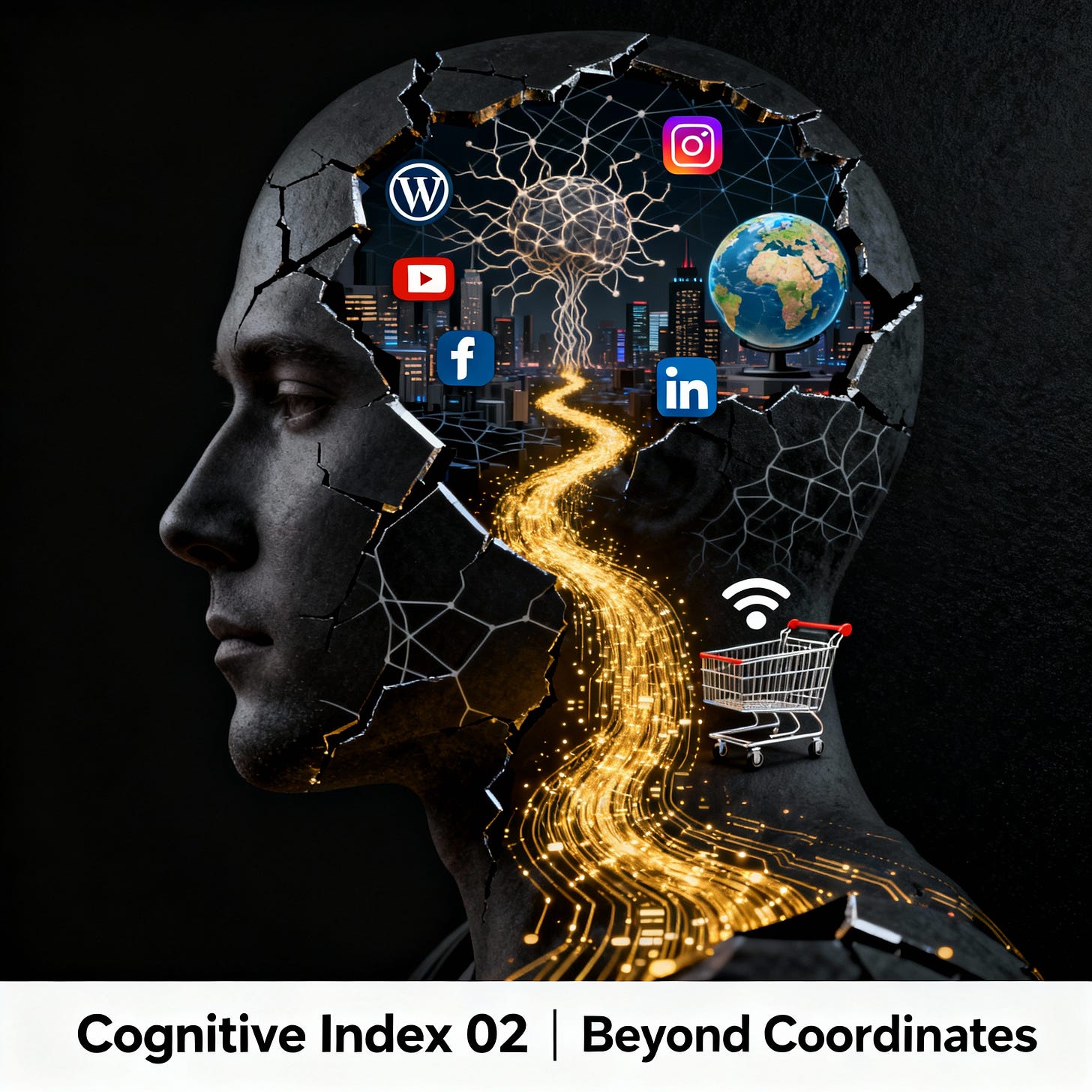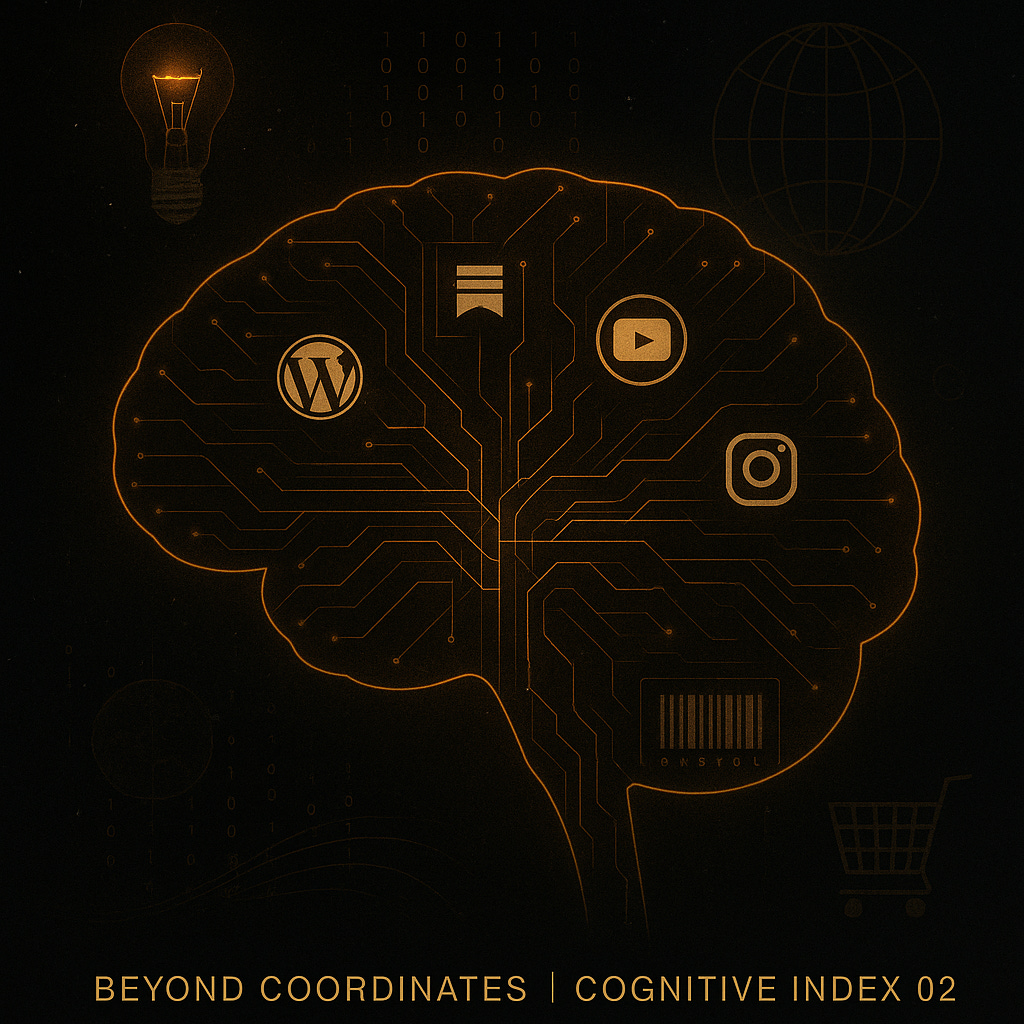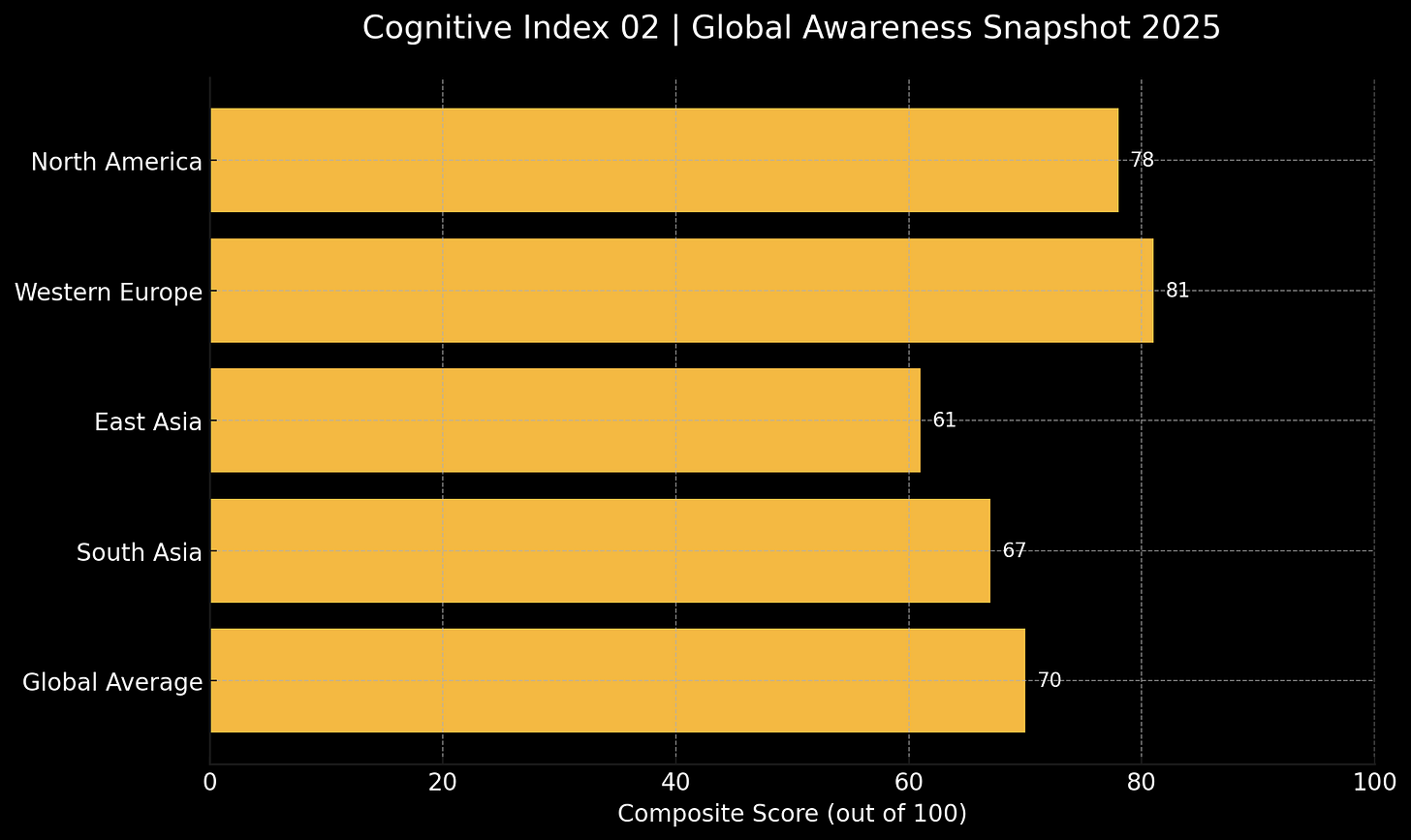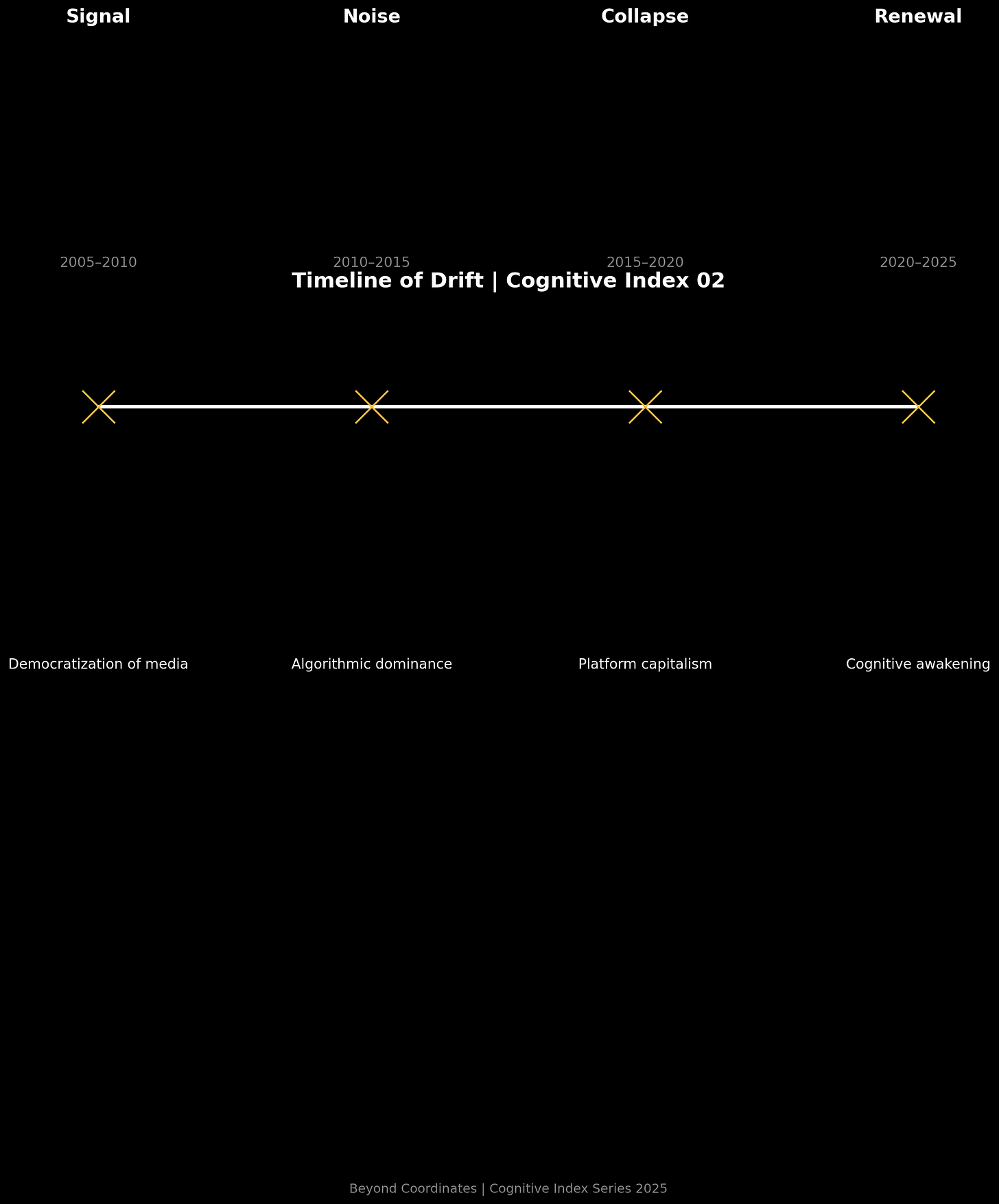Cognitive Index 02 | The Content Management of Society
Where influence became infrastructure, and attention became the new carbon.
Content management Systems VS Content Management of Society
Prologue | Influence as Infrastructure
Every civilization constructs an architecture for its mind.
The last century built its intelligence around steel, circuits, and power grids.
This century builds it around content.
From WordPress to Substack, from YouTube and Instagram to TikTok, our collective cognition is organized through platforms that manage perception as much as information. What began as a publishing tool has evolved into a system of thought distribution — one that governs how societies understand, remember, and react.
Content is no longer simply communication; it has become infrastructure.
The Architecture of Attention
The word content once described expression. Today, it defines occupation — of time, of thought, and of emotion. Governments now operate like publishers, and corporations behave like policy laboratories. The neutral platforms that once promised openness now shape visibility itself.
Every nation manages its own narrative ecosystem: part policy, part performance, and part persuasion. These networks do not silence opposition; they saturate it. The strategy is not censorship but scale — overwhelming the informational field until precision disappears in abundance.
This marks the rise of state-backed storytelling economies, where perception itself becomes a form of soft power. In this new order, legitimacy is not earned; it is engineered.
The Renting of Influence
In the corporate sphere, innovation once originated in laboratories and creative studios. Today, it begins inside someone else’s feed.
Marketing leaders have replaced invention with access, shifting budgets from research to reach. Influencers serve as brokers of authenticity; brands rent their credibility for short bursts of attention.
This model yields exposure but erodes originality.
The global Narrative Innovation Density — a metric developed within Beyond Coordinates’ Cognitive Index 02 — has declined by nearly thirty percent in five years, a direct reflection of creativity replaced by amplification.
Storytelling has not vanished; it has been outsourced.
Content as Infrastructure: The CMS Divide
In the digital century, content management systems have evolved from tools of publication to architectures of cognition. Each platform not only distributes information — it defines how societies perceive legitimacy, creativity, and continuity.
WordPress democratized publishing but externalized community. Its open framework empowered flexibility yet fractured coherence — a reflection of the early web’s decentralized promise and disjointed identity.
Substack inverted this model. It rebuilt narrative around intimacy, fostering reader-writer relationships that mimic the analog depth of correspondence. Yet its dependency on virality and email algorithms reveals the fragility of digital trust when distribution lives on borrowed channels.
YouTube transformed visual cognition — shaping not only how we learn but how we remember. Its algorithm rewards pattern over precision, creating a feedback loop where content evolves toward predictability.
TikTok and Instagram perfected the velocity economy — attention sliced into seconds, memory reduced to gesture. These platforms industrialized creativity, converting emotional nuance into engagement metrics.
LinkedIn, originally a professional registry, now mirrors performance intellectualism — insight repackaged as currency. The professional feed is no longer about knowledge sharing but self-signaling within algorithmic hierarchies.
Emerging models like Fanvue or Patreon commodify intimacy itself — monetizing access rather than ideas. In this paradigm, content management has become human management; creators are the product, and audiences the data feed.
The cognitive outcome is clear: every CMS becomes an ideology.
WordPress speaks in openness, Substack in trust, YouTube in entertainment, and TikTok in acceleration. Each reflects not merely a system of content — but a philosophy of cognition.
Measuring Awareness Infrastructure
To evaluate this transformation, the Cognitive Index 02 introduces a quantitative framework to assess the maturity of a region’s or platform’s awareness infrastructure — the systems through which societies produce, distribute, and validate information.
Dimensions of Awareness Infrastructure
Narrative Autonomy (20%)
Independence of creative voices versus institutional narratives.
Indicators: Creator-to-institution reach ratio, originality density.
Influence Integrity (20%)
Balance between authentic and paid influence.
Indicators: Disclosure compliance, engagement-trust ratio.
Governance Transparency (15%)
Clarity and accountability in content regulation.
Indicators: Provenance verification, moderation disclosure.
Platform Diversity (15%)
Degree of multi-platform resilience and decentralization.
Indicators: Platform variety, dominance index.
Cognitive Literacy (15%)
Public ability to discern truth from manipulation.
Indicators: Media literacy index, misinformation exposure.
Sustainability of Attention (15%)
Health and longevity of user engagement.
Indicators: Average session duration, fatigue indicators.
Global Awareness Infrastructure Snapshot | 2025
Global Awareness Infrastructure | Cognitive Index 02 (2025)
Score Summary: Western Europe 81, North America 78, South Asia 67, East Asia 61, Global Average 70
Status: Cognitively Evolving — Conscious but Fatigued
Insights from the Index
Influence has overtaken innovation.
Creative processes have become transactional; originality yields to optimization.
Governments operate as media entities.
Policy is packaged as performance, and communication functions as governance.
Consumers have become cognitive participants.
Each scroll, like, and share fuels algorithmic learning loops that redefine behavior itself.
B2B mirrors B2C fatigue.
Enterprise communication, once built on thought, now competes for clicks.
Platforms have replaced publishers.
Algorithms act as unseen editors, deciding what enters collective memory.
The Consumer as Cognitive Test Subject
In an environment of relentless content proliferation, consumerism has become both subject and instrument. Each recommendation is an experiment; each engagement, a data point. Consumers no longer merely purchase — they perform for the systems observing them.
This feedback loop generates an illusion of choice while engineering predictability.
It produces what the Index terms Cognitive Entropy — rising information, declining interpretation.
The B2B Reflection
The enterprise sector faces a quieter version of the same disorder.
Whitepapers, webinars, and “thought-leadership” content have turned into mechanical output where volume substitutes for value.
Yet, the organizations that retain credibility invest in proof-of-work content — material grounded in evidence, collaboration, and verifiable insight. They build audiences through demonstration, not declaration.
This is the emerging architecture of trust: depth over distribution.
Timeline of Drift (2005-2025)
Timeline of Drift (2005–2025): From Signal to Renewal — charting the rise, saturation, and recalibration of global content systems.
The Cognitive Ledger
If GDP measures production and ESG measures conscience,
then the Cognitive Index measures awareness.
In 2025, the global Awareness Infrastructure Score stands at 70 / 100 — Evolving, Self-Aware, but Fatigued.
Information is plentiful, but wisdom remains scarce.
The challenge is no longer access to knowledge; it is resistance to noise.
The Future of Consumerism | Consciousness as Commodity
Consumerism has always mirrored cognition. In the 20th century, we bought to belong; in the 21st, we consume to be seen.
The next decade will transform consumption from material to mental — from what we own to what we amplify. Every purchase, click, and subscription becomes an act of identity declaration.
As algorithmic systems personalize reality, the consumer becomes not a chooser but a participant in predictive design. Yet within this engineered attention loop lies an opportunity: a redefinition of value from accumulation to awareness. The brands and creators that survive will not compete for reach — they will cultivate relevance through moral intelligence, cognitive empathy, and sustainable storytelling.
The future of consumerism will not be defined by what we acquire, but by what we refuse to consume.
What Lies Ahead
Three structural shifts are now inevitable:
1. Provenance Becomes Policy.
Every piece of digital content will require traceability of origin, ownership, and funding.
2. Communities Outlast Platforms.
As algorithmic trust declines, curated ecosystems — newsletters, private forums, and professional collectives — will replace broad exposure.
3. Conscience Becomes Competitive.
Ethical design in communication will define future brand and governance value.
Epilogue | The Age of Rented Attention
We built data centers to remember; now we build content systems to persuade.
Governments rent narrative.
Brands rent authenticity.
Individuals rent relevance.
In this rented world, truth itself risks becoming a subscription model.
The next revolution will not come from faster communication but from slower cognition —
a deliberate return to reflection in a civilization optimized for reaction.
Because what we manage now is not merely content —
it is collective consciousness.
Signature Analysis — Beyond Coordinates (Cognitive Index Series 2025)
Cognitive Score: 70 / 100
Verdict: Cognitively Evolving, Self-Aware, Fatigued
Observation: Attention is infrastructure; narrative is power.
Mission: Mapping the world’s awareness systems — where content becomes cognition.
🧩 Methodology Note | Cognitive Index 02
The Cognitive Index 02 framework measures the evolving maturity of the world’s awareness infrastructure — the systems through which societies produce, distribute, and validate information.
The regional composite scores presented here are derived through comparative synthesis across six qualitative and quantitative dimensions: narrative autonomy, influence integrity, governance transparency, platform diversity, cognitive literacy, and sustainability of attention.
Each dimension is informed by publicly available indicators, empirical media studies, and digital governance reports. While the numerical values are interpretive rather than statistical absolutes, their directional alignment reflects verified global patterns in attention behavior, content regulation, and platform dependency.
The purpose of the Index is not measurement for precision, but measurement for perspective — to trace how cognition itself is managed, monetized, and mediated across the modern information order.
📚 Sources & Reference Frameworks
World Press Freedom Index (Reporters Without Borders, 2025) — proxy for narrative autonomy.
Measuring Media Impact (Napoli, USC Annenberg, 2024) — media accountability frameworks.
Sprinklr: Media Impact Score and Viral Nation: Influence Integrity Metrics — engagement-to-authenticity measures.
Adelaide Metrics: Attention Units (AU) and Attention Quality Index — user attention sustainability.
Smart Insights: Global Social Media Usage Report 2025 — attention time and platform concentration data.
NELA-GT-2020 Dataset (University of Michigan) — misinformation and media literacy datasets.
OECD Digital Governance Review (2024) — transparency and digital policy regulation frameworks.







Amazing article!!! Today’s reality of the CMS!! Very insightful!!
Thanks alot for encouragement and kind words 🤞✨ Keep reading and sharing your thoughts 💭